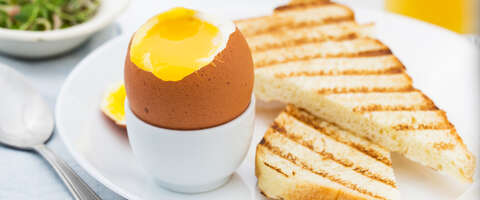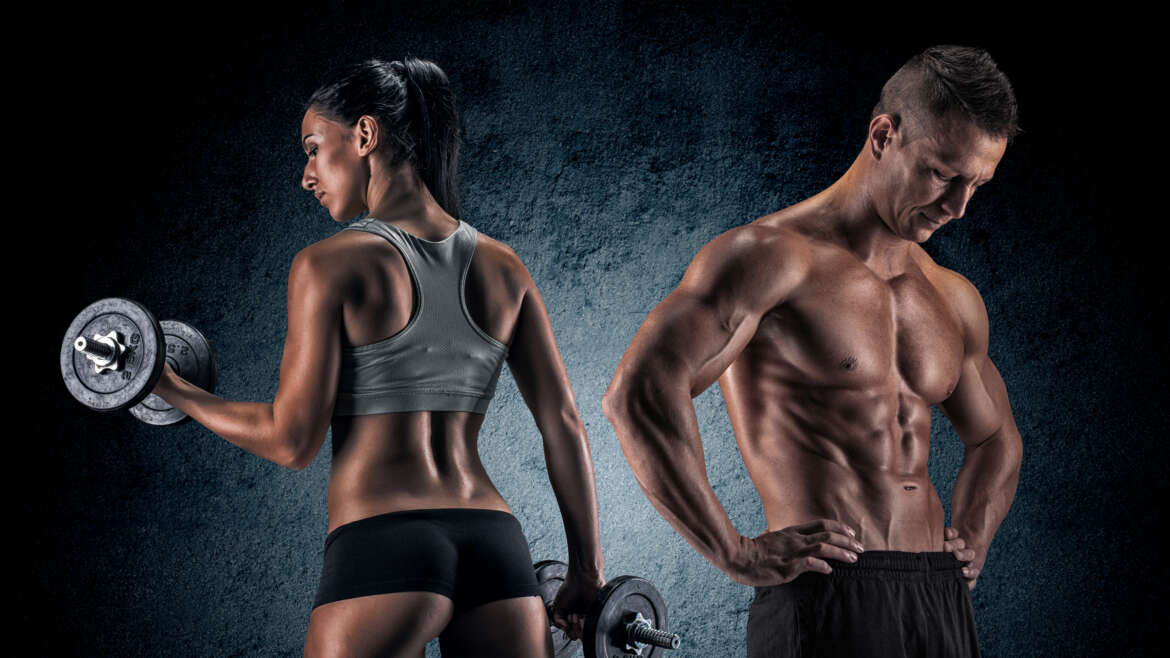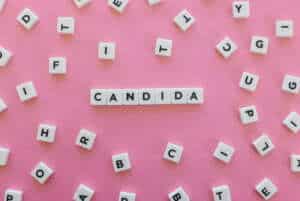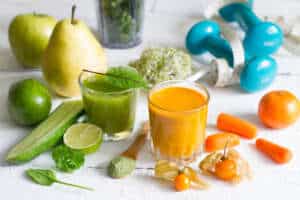Muscle Gain Diet: Do’s and Don’ts
A proper Muscle Gain Diet is no less important than intensive strength training. If, despite working hard in the gym, your muscles are not growing, it means that you are making one of the common mistakes, such as:
- Not eating enough. Starvation diets don’t help build muscle. Energy needs to be regularly replenished.
- On the contrary, you eat too much and incorrectly: you overdo simple carbohydrates (pastries, fruits, sweets), you do not observe the balance of proteins, fats, and carbohydrates. Muscle growth occurs, but it is not visible under the layer of fat.
- You do not follow the proper eating routine. For example, during the day you have irregular intervals between meals or you don’t eat all day long, and by the evening you break off. Such a diet is also not suitable for gaining muscle mass: the metabolism slows down and nutrients simply do not have time to be assimilated.
Muscle Gain: Сalories and Macronutrients
Muscle Gain Diet for men depends primarily on body weight and energy expenditure. In order to gain the minimum required number of calories each day, calculate your own individual Protein, Carbohydrates and Fats (PCF) ratio using the formula 1 kg of weight=2/4/0.7 in grams respectively.
When making a proper nutrition plan, be guided by the following calorie ratio: 1 g protein/carbohydrate=4 Kcal, 1 g fat=9 Kcal. The main source of energy during training will be carbohydrates, while proteins are used for growth and muscle strengthening. The most protein-rich foods are meat and dairy. Soybeans, legumes and nuts contain many important amino acids.
The above formula for calculating PCF is an average formula. When gaining weight, much depends on your body type and metabolic rate. If there is no increase in muscle mass over time (e.g., because of a fast metabolism), change the proportions of your diet toward more carbohydrates. Study your body and experiment!
Optimal Nutritional Routine
The number of meals in a muscle gain diet for men may vary. On average, try to eat a little but often: 4-7 times a day with breaks of 2.5-3 hours. At least three meals should contain a significant portion of protein. Such a diet promotes the production of growth hormones (very important for muscles) and reduces levels of the stress hormone cortisol.
The main meals will look like this.
Breakfast is vital to energize you for the day ahead. It should consist mainly of carbohydrates (cereals) and proteins (eggs, cheese, cottage cheese, yogurt).
Complex carbohydrates (e.g., whole wheat pasta) and proteins (meat, fish) are the main components of the lunch ration. If desired, add a vegetable dish seasoned with oil (cold-pressed and extra virgin oils have the greatest health benefits).
A proper dinner should consist of proteins and vegetables; carbohydrates should be postponed until the next morning. Eat your last meal no later than 1 to 2 hours before going to bed. It should be easily digestible protein, which will not become a stone in the stomach – yogurt or cottage cheese.
You can snack between the main meals with fresh or dried fruit and dairy products. The best sources of healthy fats in the training menu are nuts or avocados. Sports nutrition is also an excellent snack for gaining muscle mass.
Extra Foods for Muscle Growth
If you can’t get enough protein to your body weight with regular meals, ready-to-pack protein shakes and protein bars are an excellent choice. Sport foods contain protein in an easily digestible form and quickly provide your body with the essential building material for muscle fibers.
Protein is an excellent choice for:
- A snack or meal replacement during the day;
- A source of valuable amino acids 2 to 3 hours before training;
- A supplement to prevent loss of muscle tissue after a workout.
To make your diet for gaining muscle mass more calorie-dense, you can try gainers – dry protein-carbohydrate mixtures in the proportion of 20-40% proteins and 60-80% fast carbohydrates. The most effective way to consume such a supplement is as follows:
- As a snack in the first half of the day, before lunch;
- To replenish energy reserves before training (if you generally lead an active lifestyle);
- After an intense workout to “close” the protein-carbohydrate window.
You should choose between a gainer and a protein according to your objective needs. If there is not enough protein in the diet, it is better to take protein or a gainer with higher protein content. If the only question is how to get more calories, feel free to buy any gainer.
In general, sports supplements are a great and sometimes even tasty source of fast energy, but they can not completely replace the usual food. To gain weight, the diet must be complete and varied.
Useful Tips to Follow with Muscle Gain Diet
The state of water-salt metabolism in the body is very important when exercising. If there is not enough water or it is not retained, muscles lose volume dramatically. If you consume too much water, it washes out important micronutrients. It is better to drink mineral water with high potassium, sodium and chlorine content that retain water in the body and do not let the muscles “deflate”. Isotonic drinks from sport nutrition stores are considered to be a good counterpart of natural mineral water.
- Consume carbohydrates at the time of day when you wish to train so that they are converted into energy and not stored as excessive fat.
- Protein synthesis slows down during sleep. Therefore, be sure to eat a proper breakfast immediately after waking up.
- Listen to your body: If you are unable to eat the amount of food that you need according to your daily calorie calculations, do not suffer. In this case, it is better to replace one meal with a glass of protein shake.
- Prepare your menu for the week ahead. Prepared and frozen meals in advance will not allow you to break the established regime.
- Be sure to supplement a proper diet with weight training with barbells and dumbbells. Muscles will not appear on their own even with the healthiest diet. Regular targeted workouts are especially important for men of asthenic build, who find it difficult to get pumped up.
- Adhere to a training regimen. Muscles do not grow during pumping, but during recovery, so it is important to give them a rest: three days for fitness club beginners and a day and a half for experienced athletes.
- During intensive workouts, do not stick to a diet with strict restrictions, if you do not want to lose muscle mass – the body will try to save energy under stress.
Foods to Avoid During Muscle Gain Diet
While some foods help you build muscle, there are some that can slow down your progress. These include:
Alcohol can negatively affect your body’s ability to build muscle and lose fat, especially if you abuse it.
Added sugars are high in calories but low in nutrients. High-sugar foods include: candies, cookies, donuts, ice cream, brownies, and sugar-sweetened beverages such as sodas and sports drinks.
Deep-fried foods can promote inflammation and – if consumed in excess – provoke various diseases. So refuse completely or minimize your consumption of such foods as fried fish, French fries, and onion rings and deep-fried chicken strips.
Approximate Menu of a One-Week Muscle Gain Diet

Muscle Gain Diet are usually described as restrictive, repetitive and boring.
I disagree – if you want, the above recommended foods can be combined so that your muscle gain diet will be both nutritious and delicious.
Here’s an example of one-week menu.
Monday
Breakfast: scrambled eggs with mushrooms, portion of oatmeal.
Snack: low-fat Greek cottage cheese with blueberries or blueberries (fresh berries).
Lunch: venison burger, white rice and broccoli.
Afternoon snack: protein shake and banana.
Dinner: salmon, quinoa, and asparagus.
Tuesday
Breakfast: pancakes with light syrup, peanut butter and raspberries.
Snack: hard-boiled eggs and an apple.
Lunch: sirloin steak, sweet potato and spinach salad with vinaigrette.
Afternoon snack: protein shake and walnuts.
Dinner: stuffed turkey and pasta with marinara sauce.
Wednesday
Breakfast: chicken sausage with eggs and fried potatoes.
Snack: Greek yogurt and almonds.
Lunch: turkey breast, basmati rice and mushrooms.
Afternoon snack: protein shake and grapes.
Dinner: mackerel, brown rice and salad leaves with vinaigrette.
Thursday
Breakfast: stuffed turkey, egg, cheese and salsa in a whole-grain tortilla.
Snack: yogurt with granola.
Lunch: chicken breast, baked potatoes, sour cream and broccoli.
Afternoon snack: protein shake and berries.
Dinner: Roast chicken, egg, brown rice, broccoli, peas and carrots.
Friday
Breakfast: oatmeal with peaches, blueberries/blueberries, strawberries and Greek yogurt.
Snack: beef jerky and nuts.
Lunch: fillet of tilapia with lime juice, black and pink beans and seasonal vegetables.
Afternoon snack: protein shake and watermelon.
Dinner: ground beef with corn, brown rice, green peas and green beans.
Saturday
Breakfast: stuffed turkey and egg with corn, bell peppers, cheese and salsa.
Snack: can of tuna with crackers.
Lunch: fillet of tilapia, potato wedges and bell peppers.
Afternoon snack: protein shake and a pear.
Dinner: diced beef with rice, black beans, bell peppers and cheese.
Sunday
Breakfast: boiled eggs and avocado toast.
Snack: protein balls and almond butter.
Lunch: slices of pork tenderloin with roasted garlic potatoes and green beans.
Afternoon snack: protein shake and strawberries.
Dinner: turkey meatballs, pasta with marinara sauce and parmesan cheese.
Vary the different types of foods in your diet and remember to consume 20-30 grams of protein with each meal and snack.
- By Yelena B
- No Comments




Leave a reply